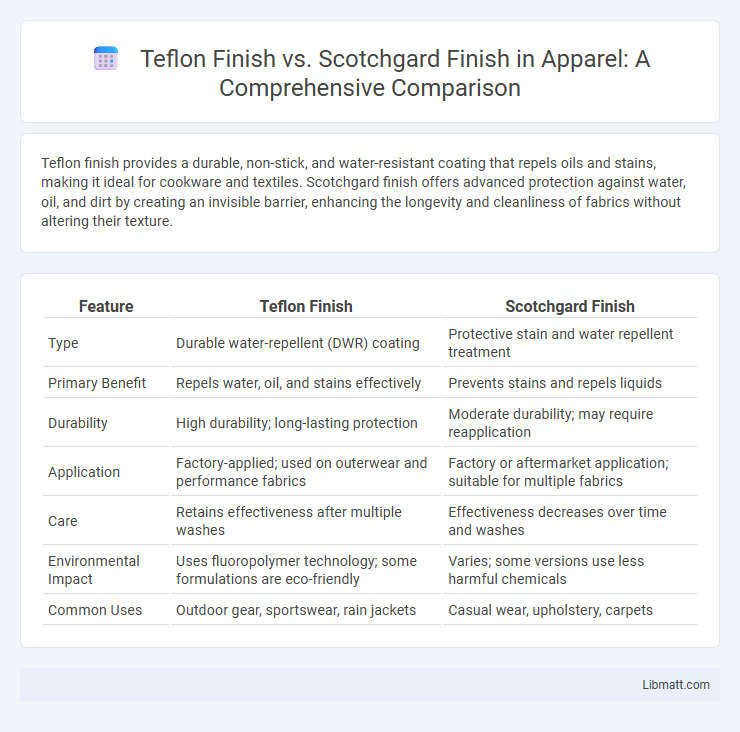Teflon finish provides a durable, non-stick, and water-resistant coating that repels oils and stains, making it ideal for cookware and textiles. Scotchgard finish offers advanced protection against water, oil, and dirt by creating an invisible barrier, enhancing the longevity and cleanliness of fabrics without altering their texture.
Table of Comparison
| Feature | Teflon Finish | Scotchgard Finish |
|---|---|---|
| Type | Durable water-repellent (DWR) coating | Protective stain and water repellent treatment |
| Primary Benefit | Repels water, oil, and stains effectively | Prevents stains and repels liquids |
| Durability | High durability; long-lasting protection | Moderate durability; may require reapplication |
| Application | Factory-applied; used on outerwear and performance fabrics | Factory or aftermarket application; suitable for multiple fabrics |
| Care | Retains effectiveness after multiple washes | Effectiveness decreases over time and washes |
| Environmental Impact | Uses fluoropolymer technology; some formulations are eco-friendly | Varies; some versions use less harmful chemicals |
| Common Uses | Outdoor gear, sportswear, rain jackets | Casual wear, upholstery, carpets |
Introduction to Fabric Protection Finishes
Teflon finish and Scotchgard finish are two popular fabric protection treatments designed to repel stains, water, and dirt. Teflon finish forms a microscopic protective barrier that resists oils and liquids, maintaining fabric breathability and softness. Scotchgard finish utilizes a fluoropolymer-based coating to enhance durability against spills and stains while preserving fabric texture and color vibrancy.
What is Teflon Finish?
Teflon finish is a durable, water- and stain-resistant coating made from polytetrafluoroethylene (PTFE) that protects fabrics and surfaces by repelling liquids and preventing dirt from penetrating fibers. This proprietary finish enhances the longevity and appearance of your textiles by facilitating easy cleaning and reducing wear from spills and stains. Unlike other coatings, Teflon forms a protective barrier that maintains breathability while providing long-lasting performance in both indoor and outdoor applications.
What is Scotchgard Finish?
Scotchgard finish is a protective treatment designed to repel water, oil, and stains, extending the life and appearance of fabrics, upholstery, and carpets. It creates an invisible barrier that prevents liquids and dirt from penetrating the material, making cleaning easier and preserving your items. Unlike Teflon finish, which often emphasizes durability and heat resistance, Scotchgard focuses primarily on stain and spill resistance for everyday fabric protection.
Key Differences Between Teflon and Scotchgard
Teflon finish provides a durable, fluoropolymer-based coating that offers strong resistance to stains, water, and oil by creating a non-stick surface on fabrics, whereas Scotchgard finish uses a fluorochemical treatment designed to repel liquids and prevent staining through surface tension alteration. Teflon tends to be more abrasion-resistant, making it suitable for heavy-use textiles, while Scotchgard emphasizes maintaining fabric breathability and softness alongside stain protection. The chemical composition and application methods differ, with Teflon often requiring heat curing, and Scotchgard applied as a spray or rinse, influencing both performance longevity and fabric feel.
Performance and Effectiveness Comparison
Teflon finish provides a durable, long-lasting protective barrier that resists stains, water, and oils by creating a non-stick surface ideal for fabrics exposed to heavy use. Scotchgard finish excels in repelling liquids and preventing stains through a fluorochemical treatment that maintains fabric breathability while offering effective protection. Your choice depends on whether you prioritize the superior durability of Teflon or the advanced stain-resistant technology of Scotchgard for maintaining fabric appearance.
Application Methods: Teflon vs. Scotchgard
Teflon finish is typically applied through a spray or dip method, creating a durable, water-repellent coating on fabric surfaces that resists stains and dirt. Scotchgard finish, often applied as a spray-on treatment, forms a protective barrier that repels liquids and prevents stains from penetrating fibers, ideal for upholstery and carpets. Your choice depends on the fabric type and desired protection level, with Teflon offering longer-lasting results and Scotchgard allowing easier reapplication.
Durability and Lifespan of Each Finish
Teflon finish offers superior durability with strong resistance to stains, water, and scratches, ensuring a longer lifespan especially in high-traffic or heavily used environments. Scotchgard finish provides excellent protection against spills and stains but may require more frequent reapplications to maintain its effectiveness over time. Your choice depends on the level of wear and maintenance you're prepared to manage, with Teflon generally delivering more lasting protection.
Safety and Environmental Impact
Teflon finish, made from polytetrafluoroethylene (PTFE), has raised concerns due to potential release of harmful perfluorooctanoic acid (PFOA) during manufacturing, impacting environmental safety. Scotchgard finish, primarily formulated with PFAS chemicals, can persist in the environment and pose risks to water sources and human health. Your choice should consider that while both finishes offer stain resistance, Scotchgard is often promoted for its lower toxicity and regulatory compliance compared to traditional Teflon coatings.
Cost Considerations
Teflon finish typically incurs higher initial costs due to advanced chemical technology providing durable stain and water resistance, making it suitable for long-term use. Scotchgard finish offers a more budget-friendly option with effective but sometimes less robust protection, appealing to consumers seeking economical stain repellency. Cost considerations should weigh the upfront price against the desired longevity and performance of the fabric protection.
Which Finish Should You Choose?
Choosing between Teflon finish and Scotchgard finish depends on the intended application and fabric type, with Teflon providing superior oil and water repellency ideal for outdoor gear and durable clothing. Scotchgard excels in maintaining fabric breathability while offering effective stain and water resistance, making it suitable for upholstery and everyday wear. Consider Teflon for high-performance protection and Scotchgard for versatile, breathable fabric preservation.
Teflon finish vs Scotchgard finish Infographic

 libmatt.com
libmatt.com